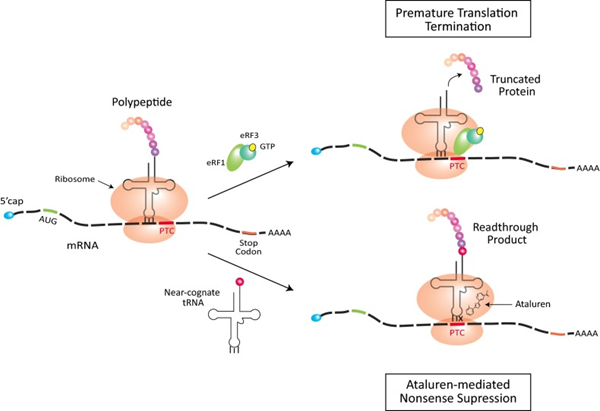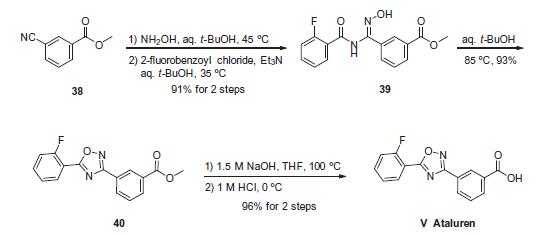Ataluren
|
|
|
- CAS-Nr.
- 775304-57-9
- Englisch Name:
- Ataluren
- Synonyma:
- Ataluren;Ptc124;CS-749;Ptc-124;Ptc 124;Atarulon;Ataluren [usan];Ataluren, >=98%;PTC-124,ataluren;Ataluren (PTC124)
- CBNumber:
- CB02128667
- Summenformel:
- C15H9FN2O3
- Molgewicht:
- 284.24
- MOL-Datei:
- 775304-57-9.mol
|
Ataluren Eigenschaften
- Schmelzpunkt:
- 241 - 242°C
- Siedepunkt:
- 503.7±60.0 °C(Predicted)
- Dichte
- 1.379
- storage temp.
- Refrigerator
- L?slichkeit
- DMSO (Slightly)
- Aggregatzustand
- White to off-white solid.
- pka
- 3.58±0.10(Predicted)
- Farbe
- White to Off-White
- InChI
- InChI=1S/C15H9FN2O3/c16-12-7-2-1-6-11(12)14-17-13(18-21-14)9-4-3-5-10(8-9)15(19)20/h1-8H,(H,19,20)
- InChIKey
- OOUGLTULBSNHNF-UHFFFAOYSA-N
- SMILES
- C(O)(=O)C1=CC=CC(C2N=C(C3=CC=CC=C3F)ON=2)=C1
- CAS Datenbank
- 775304-57-9
Sicherheit
- Risiko- und Sicherheitserkl?rung
- Gefahreninformationscode (GHS)
| Bildanzeige (GHS) |
 
|
| Alarmwort |
Warnung |
| Gefahrenhinweise |
| Code |
Gefahrenhinweise |
Gefahrenklasse |
Abteilung |
Alarmwort |
Symbol |
P-Code |
| H336 |
Kann Schl?frigkeit und Benommenheit verursachen. |
Spezifische Zielorgan-Toxizit?t (einmalige Exposition) |
Kategorie 3 (Schl?frigkeit und Benommenheit) |
Warnung |
|
P261, P271, P304+P340, P312,P403+P233, P405, P501 |
| H373 |
Kann die Organe sch?digen bei l?ngerer oder wiederholter Exposition. |
Spezifische Zielorgan-Toxizit?t (wiederholte Exposition) |
Kategorie 2 |
Warnung |
|
P260, P314, P501 |
|
| Sicherheit |
| P260 |
Dampf/Aerosol/Nebel nicht einatmen. |
| P271 |
Nur im Freien oder in gut belüfteten R?umen verwenden. |
| P314 |
Bei Unwohlsein ?rztlichen Rat einholen / ?rztliche Hilfe hinzuziehen. |
| P403+P233 |
An einem gut belüfteten Ort aufbewahren. Beh?lter dicht verschlossen halten. |
| P405 |
Unter Verschluss aufbewahren. |
|
Ataluren Chemische Eigenschaften,Einsatz,Produktion Methoden
Beschreibung
Ataluren is a drug marketed under the trade name Translarna®
which was developed by PTC Therapeutics and approved by the
European Union in May 2014 for the treatment of Duchenne’s muscular
dystrophy (DMD) and potentially other genetic disorders.
Ataluren renders ribosomes less sensitive to premature stop or
‘read-through’ codons, which are thought to be beneficial in diseases
such as DMD and cystic fibrosis.
Verwenden
Nonsense mutations create a premature termination of mRNA translation and have been implicated in various genetic disorders, including muscular dystrophy and cystic fibrosis. PTC-124 is a nonaminoglycoside that has been reported to selectively induce ribosomes to read through premature nonsense stop signals on mRNA, thus allowing the production of full-length, functional proteins. In a mouse model of cystic fibrosis caused by nonsense mutations, PTC-124 treatment (60 mg/kg s.c. injection or 0.3-0.9 mg/ml orally) has been shown to restore cystic fibrosis transmembrane conductance regulator (CFTR) protein expression and function. The target activity of PTC-124 was initially evaluated by firefly luciferase reporter cell-based nonsense codon assay (IC50 = 7 nM); however, subsequent assessments using a Renilla reniformis luciferase reporter have failed to produce nonsense codon suppression activity. Thus, while PTC-124 is in clinical testing in patients with nonsense mutations within the CFTR or dystrophin genes, controversy surrounds its exact mechanism of action.[Cayman Chemical]
Mechanism of action
The mechanism of action of Ataluren (PTC124) is to generate functionally normal myotonic dystrophy proteins by facilitating ribosomal read-through of nonsense mutations, thereby bypassing the pathogenic variant and continuing the translation process. Under normal conditions, ribosomes move along the mRNA that links amino acids into proteins until they reach the stop codon. When the ribosome encounters a premature termination codon (PTC) due to a nonsense mutation, eukaryotic release factors [eRF1 (green) and eRF3 (turquoise) complexed with GTP (yellow)] are recruited, and translation is terminated prematurely to produce the truncated protein. Ataluren is thought to interact with the ribosome to promote the recruitment of the proximity-recognition tRNAs, which in turn inhibits the nonsense mutation, allowing the PTC to be read through and synthesised. PTC to be read through and synthesise full-length proteins. The red amino acid on the near-recognition tRNA is incorporated into the read-through protein product. In the Ataluren-mediated nonsense repression model, the X on the tRNA indicates a mispairing at codon position three.

Synthese
The sequence to construct ataluren, which was described by the
authors at PTC Therapeutics, commenced with commercially available
methyl 3-cyanobenzoate (38). This ester was exposed to
hydroxylamine in aqueous tert-butanol and warmed gently until
the reaction was deemed complete. Then this mixture was treated
with 2-fluorobenzoyl chloride dropwise and subsequently triethylamine
dropwise. To minimize exotherm and undesired side products,
careful control of the addition of reagents was achieved
through slow dropwise addition of these liquid reagents. Upon
complete consumption of starting materials and formation of amidooxime
39, the aqueous reaction mixture was then heated to
85 ?? to facilitate 1,2,4-oxadiazole formation, resulting in the tricyclic
ester 40 in excellent yield across the three steps. Finally,
saponification of ester 40 through the use of sodium hydroxide followed
by acidic quench gave ataluren (V) in 96% over the two-step
sequence.

Ataluren Upstream-Materialien And Downstream Produkte
Upstream-Materialien
Downstream Produkte
Ataluren Anbieter Lieferant Produzent Hersteller Vertrieb H?ndler.
Global( 230)Lieferanten
775304-57-9()Verwandte Suche:
- Ptc-124
- PTC-124,ataluren
- Ataluren (PTC124)
- Ataluren PTC 124 Ataluren
- Ataluren, >=98%
- PTC124, 775304-57-9
- 3-[5-(2-Fluorophenyl)-1,2,4-oxadiazol-3-yl]benzoic acid
- Ataluren [usan]
- Benzoic acid, 3-(5-(2-fluorophenyl)-1,2,4-oxadiazol-3-yl)-
- Ptc 124
- Atarulon
- CS-749
- ATALUREN;PTC-124;PTC 124
- Ataluren (PTC124) USP/EP/BP
- Ptc124
- Ataluren
- 4H-1-Benzopyran-4-one,6-bromo-2,3-dihydro-2,7-dimethyl-
- Estr-4-en-3-one,17-hydroxy-,(21β)-
- 775304-57-9
- C15H9FN2O3
- Inhibitors
- Ribosome binding agent
- API

